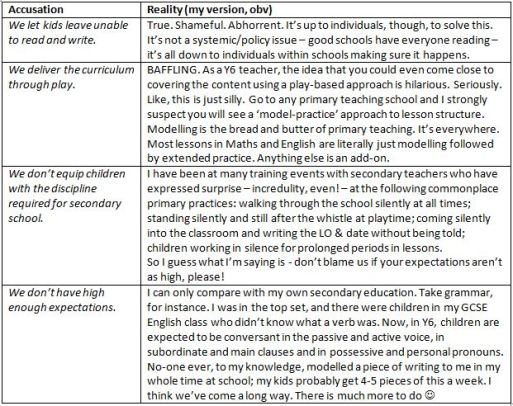Guided reading is fun. I love teaching it. Spending a half hour chatting about literature and scribbling on whiteboards with a small group of children while the rest beaver away in silence is the closest we can get to a break in class 🙂
But I worry about it. How much impact can one 30-minute session a week have on children? Wouldn’t it be better if children were reading purposefully every day?
Well. I’ve been teaching a group of children using a very structured phonics programme this year, and it’s got me thinking about how we could use a similar approach with children of all abilities in whole-class teaching.
So today, when I couldn’t sleep, I thought about how I’d plan out a week’s worth of work based on a short text for whole class teaching, in such a way that all the key reading skills – decoding, comprehension, inference, commenting on language, summarising and empathising – could be covered every single week. Obviously choice of text and pitch would be really key; good behaviour management of paired work would also be vital.
The list below (sorry, don’t know how to make a table!) is what I came up with – I’ve just summarised what the content might look like. I’ve never taught like this – it might be way too much to fit in to a 30 minute session – but damn I would love to try it! So this is really just a ‘putting this out there’ thing – would love to hear if anyone does anything similar and how it works 🙂
Any suggestions for improvements, missing areas, or ideas also very gratefully received!
Monday – vocabulary and decoding
– Introduce text orally by relating it to children’s prior reading or own experiences e.g. tell your partner about a time you saw a wild animal…This text is about lions…
– Introduce any challenging vocabulary by giving a range of examples and asking children to complete cloze sentences using the new vocabulary
– Practise reading all tricky words in the text at speed from a grid in pairs.
– Read the text in pairs for decoding, alternating short sections or paragraphs (re-read if they finish early).
– Teacher reads aloud and pauses at certain words – class fills the next word in.
– As a class generate a flow-chart of the key points to display – with the new vocab – throughout the week.
Tuesday – comprehension
– Recap any words and vocabulary the children struggled with yesterday
– Repeat the speed-reading word grid task
– Re-read the text in pairs focusing on understanding
– Read around the room – say a child’s name and they pick up reading – 1 or 2 passages only. Note which children were picked.
– Model finding answers to retrieval questions e.g. what happened after…?
– Practise retrieval questions
Wednesday – fluency & inference
– Re-read the text in pairs a final time, focusing on a particular aspect of fluency and expression e.g. dialogue, pausing, pace.
– Model reading a chosen section with the target expression. Children practise in pairs; share randomly.
– Model finding evidence to support ‘how do we know?’ (inference) questions e.g. how do we know she is angry? Or more advanced – What is she feeling and how do you know? Children can highlight in text for these model questions.
– Children practise ‘how do we know?’ questions
Thursday – summarising & commenting on language use
– Model summarising a section of the text in a given number of words.
– Children summarise each section in writing in a given number of words.
– Discuss the writer’s use of language and model answering questions about this. E.g. which words made the house sound scary? Why did the author use the word…? Use a bank of phrases to refer to e.g. gives the impression that…
– Children practise questions about the writer’s use of language.
Friday – empathising & linking to the wider world
– Use hot-seating or paired discussion to put yourself in role as a character from the text (or a hypothetical person linked to a non-fiction text).
– Model writing in role e.g. at different points in the story, what might Sophie be thinking to herself?
– Children write in role.
– Draw a philosophical or discussion question out from the text e.g. should people follow their dreams even if it hurts others? Ask children to explain why you have chosen this question (later, children could generate their own). Give time for partner talk, then discuss as a class, taking volunteered contributions.
